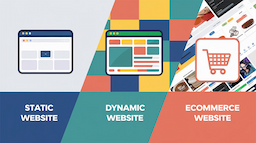What is a Responsive E-Commerce Modern HTML Template?

Introduction:
In the dynamic realm of online business, creating a visually appealing and functional e-commerce website is crucial for success. One of the key elements that contribute to a seamless user experience is a responsive e-commerce modern HTML template. In this comprehensive guide, we'll delve into the intricacies of what makes a template responsive, modern, and suitable for e-commerce purposes.
Understanding the Basics of Responsive Design
Responsive design is an approach to web design that ensures a website's layout adjusts seamlessly to different screen sizes and devices. A responsive e-commerce modern HTML template is crafted with this principle in mind, offering a consistent and user-friendly experience across desktops, tablets, and mobile devices.
Key Features of Responsive E-Commerce Modern HTML Templates
Fluid Grid Layouts: Responsive templates use fluid grid layouts that adapt to various screen sizes, ensuring a harmonious presentation of content.
Flexible Images and Media: Images and media elements are coded to resize proportionally, preventing distortion and maintaining visual appeal.
Media Queries: CSS media queries are employed to apply specific styles based on the device characteristics, optimizing the site's appearance accordingly.
Mobile-Friendly Navigation: Responsive e-commerce templates incorporate intuitive and touch-friendly navigation menus, enhancing the user experience on mobile devices.
The Significance of Modern HTML
HTML (Hypertext Markup Language) is the backbone of any web page, and modern HTML practices play a crucial role in the development of e-commerce websites.
HTML5 and Its Impact
HTML5, the latest version of HTML, introduces new elements and attributes that enhance the structure and functionality of web pages. E-commerce websites leveraging modern HTML5 features benefit from improved performance, better semantics, and enhanced multimedia support.
Why Choose a Responsive E-Commerce Modern HTML Template?
Enhanced User Experience: Responsive design ensures that visitors enjoy a seamless and consistent experience, regardless of the device they use to access the website.
SEO Benefits: Search engines prioritize mobile-friendly websites, and a responsive template positively impacts your site's search engine rankings.
Cost-Effective Solution: Instead of developing separate templates for different devices, a responsive template streamlines the development process and reduces overall costs.
Adaptability to Technological Advances: Modern HTML templates are designed to adapt to the ever-evolving landscape of web technologies, ensuring your e-commerce site remains relevant and up-to-date.
Responsive E-Commerce Modern HTML Template Best Practices
Optimized Images: Compress and optimize images to improve page load times without sacrificing quality.
CSS and JavaScript Optimization: Minimize and combine CSS and JavaScript files to reduce the number of server requests, enhancing site speed.
Cross-Browser Compatibility: Test your template across various browsers to ensure consistent performance for all users.
Responsive E-Commerce Modern HTML Template: A Wise Investment
In the competitive world of online commerce, investing in a responsive e-commerce modern HTML template is a strategic decision that pays off in the long run. By combining the flexibility of responsive design with the power of modern HTML, your e-commerce site can provide a user experience that sets it apart from the competition.
ECommerce Website Package Pricing in India
When considering the implementation of a responsive e-commerce modern HTML template, it's essential to factor in the overall cost of your e-commerce website. In India, where the e-commerce landscape is thriving, understanding the pricing structure for website development packages is crucial.
Basic Package: Ideal for small businesses or startups, this package includes essential features like a responsive design, product catalog, and secure payment gateways.
Standard Package: Geared towards growing enterprises, the standard package may include advanced features such as inventory management, order tracking, and basic SEO optimization.
Premium Package: Tailored for established businesses, the premium package encompasses advanced functionalities like customer analytics, multi-channel integration, and robust security measures.
Conclusion
In conclusion, a responsive e-commerce modern HTML template is the foundation of a successful online presence. By embracing the principles of responsive design and incorporating modern HTML practices, your e-commerce website can deliver a user experience that not only meets but exceeds customer expectations.
Remember, when considering the implementation of a responsive e-commerce modern HTML template, it's crucial to align your choice with your business goals and user needs. Keep the focus on creating a website that not only looks stunning but also functions seamlessly across devices, contributing to the growth and success of your e-commerce venture.
FAQ: Frequently Asked Questions
Q1: What exactly is a responsive e-commerce modern HTML template?
A1: A responsive e-commerce modern HTML template is a pre-designed web page layout crafted with HTML (Hypertext Markup Language) that adapts seamlessly to different screen sizes and devices. It incorporates modern HTML practices to ensure an aesthetically pleasing and functional design for e-commerce websites.
Q2: How does responsive design work in an HTML template?
A2: Responsive design employs fluid grid layouts, flexible images, and CSS media queries to ensure that the web page adjusts proportionally to varying screen sizes. This approach enhances user experience by providing a consistent look and feel across desktops, tablets, and mobile devices.
Q3: Why is a responsive e-commerce template important for my online store?
A3: A responsive template is crucial for your online store because it guarantees a seamless user experience, improves search engine rankings (due to mobile-friendliness), and offers a cost-effective solution by eliminating the need for separate templates for different devices.
Q4: What are the key features of responsive e-commerce modern HTML templates?
A4: The key features include fluid grid layouts, flexible images and media, CSS media queries, and mobile-friendly navigation. These features collectively contribute to a responsive design that ensures a positive user experience across various devices.
Q5: How does modern HTML (HTML5) impact the development of e-commerce websites?
A5: Modern HTML, particularly HTML5, introduces new elements and attributes that enhance the structure and functionality of web pages. E-commerce websites leveraging HTML5 benefit from improved performance, better semantics, and enhanced multimedia support.
Q6: Are there any SEO benefits to using a responsive e-commerce modern HTML template?
A6: Yes, there are significant SEO benefits. Search engines prioritize mobile-friendly websites, and a responsive template positively impacts your site's search engine rankings, leading to increased visibility and potential traffic.
Q7: What best practices should be followed when using a responsive e-commerce modern HTML template?
A7: Best practices include optimizing images, CSS, and JavaScript, ensuring cross-browser compatibility, and regularly testing the template to maintain consistent performance. These practices contribute to faster page load times and an overall improved user experience.
Q8: How can I determine the right e-commerce website package pricing in India?
A8: The e-commerce website package pricing in India varies based on the features offered. Basic packages cater to small businesses, standard packages suit growing enterprises, and premium packages are designed for established businesses. Consider your specific business needs and growth goals when evaluating package options.
Read also:
How Much Does it Cost to Develop a React Native Mobile App?
What are the Basic Requirements for iOS App Development?
Pros and Cons of iOS app Development
11 Reason Why Mobile App Development is Important for Your Business in 2024
9 Reasons Why a Logo is Important to Your Business?
Which Costs More, The Websites or The Mobile App?
Recent Blogs

12 Key Features to Have on Your Jewelry eCommerce Website

9 Reasons Your Website Visitors Aren’t Converting
